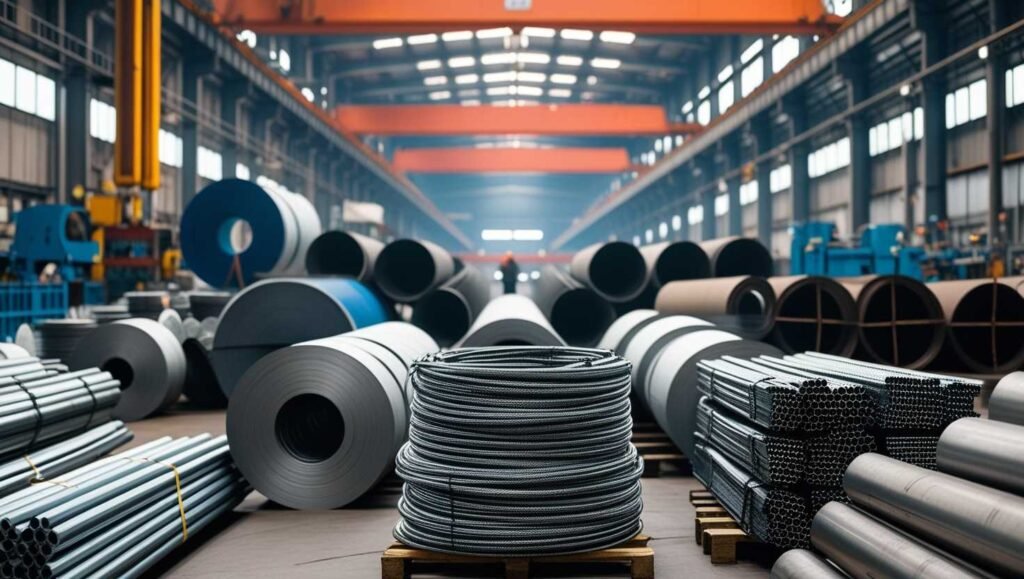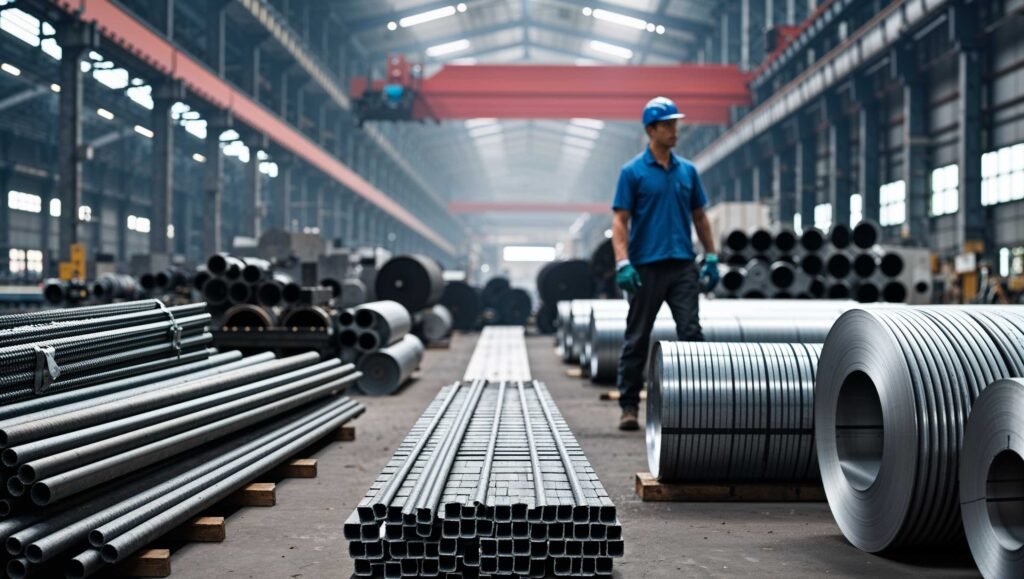Table of Contents
Here you will find latest steel price per kg in 2025. Steel is one of the most critical materials in modern construction, manufacturing, and industrial sectors. Steel price account for major portion in any house construction.
Cost of steel in any construction is approximately 15% to 20% of total cost. Here we have shown the latest steel price per kg in 2025 to help you plan budget for your new home construction.

What Is the Latest Steel Price Per Kg in India?
As of January 2025, steel prices vary depending on the type, grade, and manufacturer. Below is an overview of common steel categories and their approximate prices:
- Mild Steel: ₹60–₹75 per kg
- Stainless Steel (304 Grade): ₹250–₹320 per kg
- Stainless Steel (316 Grade): ₹320–₹390 per kg
- Hot-Rolled Coil (HRC): ₹60,000 per metric tonne (~₹60 per kg)
- Cold-Rolled Coil (CRC): ₹89,000 per metric tonne (~₹89 per kg)
Prices fluctuate based on demand-supply dynamics, regional disparities, and raw material costs. Below we have discussed in detail the major factor affecting steel prices.
| Steel Category | Grade/Type | Price (₹/kg) |
|---|---|---|
| TMT Rebars | Fe 415 | 55 |
| Fe 500 | 58 | |
| Fe 500D | 59 | |
| Fe 550 | 60.5 | |
| Fe 600 | 62 | |
| Hot-Rolled Coils (HRC) | ASTM A36 | 60 |
| ASTM A572 | 61.5 | |
| IS 2062 | 63 | |
| JIS G3101 | 62 | |
| Mild Steel (MS) Plates | IS 2062 E250 | 66 |
| IS 2062 E350 | 70 | |
| IS 10748 | 68 | |
| Cold-Rolled Coils (CRC) | SPCC | 72 |
| CR3 | 74 | |
| IS 513 | 75 | |
| Galvanized Steel (GP) Sheets | IS 277 | 68 |
| ASTM A653 | 69.5 | |
| EN 10346 | 71 | |
| Pre-Painted Galvanized Sheets | IS 15961 | 80 |
| ASTM A755 | 82 | |
| Stainless Steel | SS 304 | 270 |
| SS 316 | 300 | |
| SS 410 | 250 | |
| Carbon Steel Pipes | ASTM A106 Gr B | 80 |
| API 5L X52 | 84 | |
| ASTM A53 Gr B | 78.5 | |
| Structural Steel | IS 800 | 65 |
| IS 808 | 66 | |
| IS 13920 | 70 | |
| Steel Angles | IS 2062 | 61 |
| IS 808 | 63 | |
| Steel Beams | IS 2062 | 75 |
| IS 11309 | 77 | |
| Wire Rods | IS 2885 | 68 |
| SAE 1010 | 70 | |
| SAE 1020 | 72 | |
| Steel Billets | IS 2830 | 56 |
| SAE 1040 | 58 |
Note: Prices are approximate and based on the latest available market data. Actual rates may vary depending on location and market conditions. Always consult local suppliers for the most accurate and up-to-date pricing.
Factors Affecting Steel Prices Per Kg

1. Raw Material Costs
Steel production relies heavily on iron ore, coal, and scrap metal. Any fluctuation in the prices of these raw materials directly impacts steel prices. For example, if the cost of high-grade iron ore rises, manufacturers often transfer this increase to the consumer.
2. Manufacturing Process
The production method—whether hot-rolled, cold-rolled, or galvanized—affects the cost. Cold-rolled steel, known for its superior finish and strength, is more expensive than hot-rolled steel.
3. Market Demand and Supply
Economic activity, infrastructure projects, and industrial growth contribute to fluctuations in demand. For instance, during peak construction seasons, steel prices per kg often increase due to heightened demand.
4. Import and Export Policies
Trade tariffs, import duties, and global economic policies significantly influence local steel prices. Countries that impose high import taxes often see a rise in domestic steel prices.
5. Regional Variations
Prices can vary from one state to another due to transportation costs, regional taxes, and proximity to production hubs.
Types of Steel and Their Pricing
1. Mild Steel
Mild steel is the most commonly used type for construction purposes due to its affordability and flexibility. With prices ranging from ₹60 to ₹75 per kg, it is ideal for making structural beams, bars, and plates.
2. Stainless Steel
Known for its corrosion resistance, stainless steel is widely used in kitchenware, medical equipment, and construction.
- 304 Grade: Offers excellent corrosion resistance, priced between ₹250–₹320 per kg.
- 316 Grade: Superior to 304 due to its higher resistance to corrosion, priced at ₹320–₹390 per kg.
3. Alloy Steel
This type contains additional elements such as chromium, nickel, and molybdenum to enhance strength and durability. Prices vary based on the specific alloy composition.
4. Tool Steel
Used in manufacturing cutting and drilling tools, tool steel is expensive, with prices starting at ₹200 per kg and going higher depending on the grade.
Regional Trends in Steel Pricing
1. Northern India
Northern states like Punjab and Haryana, being close to steel manufacturing hubs, generally offer competitive prices for mild and stainless steel.
2. Western India
With ports facilitating imports and exports, states like Gujarat and Maharashtra see lower costs for imported grades of steel.
3. Southern India
Transportation costs from manufacturing plants in other regions may increase steel prices slightly in southern states.
4. Eastern India
Rich in raw materials like iron ore, eastern India benefits from lower production costs, making steel more affordable.

Steel Price Forecast for 2025
Market analysts predict that steel prices will remain steady in the first quarter of 2025. However, potential disruptions in global supply chains or increases in raw material costs may lead to fluctuations. Key factors to monitor include:
- Global Economic Recovery: The pace of recovery from global recessions impacts steel demand.
- Government Policies: Infrastructure projects under government schemes may drive demand.
- Currency Exchange Rates: A weaker rupee can make imported steel more expensive.
How to Make Cost-Effective Steel Purchases
1. Compare Prices
Always compare rates from multiple suppliers to secure the best deal.
2. Bulk Purchases
Buying in bulk often leads to discounted rates and better negotiation leverage.
3. Monitor Market Trends
Keep an eye on market forecasts and purchase during periods of lower demand.
4. Opt for Local Suppliers
Local suppliers can reduce transportation costs, making your purchase more affordable.
Conclusion
Understanding the dynamics of steel prices per kg is essential for making informed purchasing decisions. Whether you’re a contractor, a manufacturer, or an individual buyer, staying updated on market trends, regional variations, and global factors can help you save costs while ensuring quality.
Why Steel prices are decreased when compared to the Fy 2025 with Fy 2024 in Andhra Pradesh